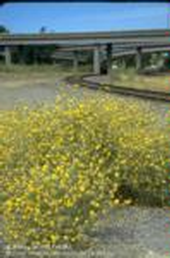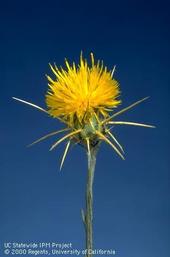- Author: Rebecca Miller-Cripps

Along scenic corridors, county roads and state highways of the foothills of the Sierra Nevada mountain range, weeds—especially yellow starthistle and Italian thistle—are creating solid stands of invasion that defy control.
The California Department of Transportation (CalTrans) manages over 15,000 miles of roadway and over 230,000 acres of right of way. Along state highways CalTrans manages a narrow easement strip on either side of the roadway for vegetation control. According to CalTrans, vegetation management is performed to: 1. reduce fire risk, 2. improve line of sight and 3. increase visibility; 4. protect road edges from weed damage. Noxious weed control is the last priority listed.
However,...
- Author: Gale Perez
Below is a link to the Nov. 2012 UCCE San Joaquin County newsletter Field Notes. Page 8 has an article by Mick Canevari (Emeritus Farm Advisor) and Brent Holtz (Farm Advisor, County Director) on dormant weed control in tree nut crops.
http://cesanjoaquin.ucanr.edu/newsletters/Field_Notes_Newsletter44986.pdf
- Posted by: David Low
- Re-posted by: Gale Perez
Abstract
Non-synthetic herbicides offer a potentially useful addition to the suite of weed management tools available to organic growers, but limited information is available to guide the optimal use of these products. The objectives of this research were to 1) evaluate the efficacy of clove oil and vinegar based herbicides on weeds across multiple states, and 2) assess the potential role of temperature, relative humidity (RH) and cloud cover in explaining inter-state variations in results. From 2006 to 2008, a total of 20 field trials were conducted in 7 states using an identical protocol. Seeds of brown mustard were sown and herbicides applied to both mustard and emerged weeds when mustard reached the 3-4 leaf...
- Author: Richard Smith
- Posted by: Gale Perez

The development of improved cultivation technology for row crop production has been an active area of research, and has made significant progress in recent years. Currently, standard cultivation removes weeds from the majority of the bed using sweeps, knives, coulters and blades. Typically a 4-inch wide band is left around the seedline. Weeds in the uncultivated band are typically removed by hand, and the density of weeds that occur there, determines how laborious and costly subsequent hand weeding will be.
There is technology to remove weeds from the seedline and it generally falls into two categories: 1) blind cultivation and 2) computer assisted cultivators. Implements used for blind cultivation are not guided by a...
- Author: Rebecca Miller-Cripps
- Contributor: Wendy West

Collaboration between Partners May Be an Effective Way to Fund Wildland Weed Control Projects
Many funding sources for weed eradication have been reduced or completely eliminated. According to the California Assembly Budget Committee's annual Preliminary Review of the Governor's Proposed 2012-13 State Budget, the California Department of Food and Agriculture will absorb a permanent budget reduction of $12 million in program cuts, in addition to a $19 million budget reduction in 2011-12. Funding for Weed Management Areas (WMAs) has been reduced to the...


